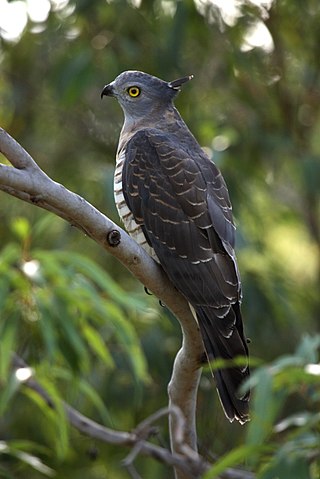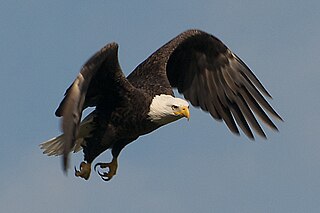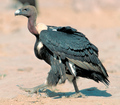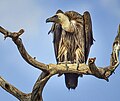
Birds of prey or predatory birds, also known as raptors, are hypercarnivorous bird species that actively hunt and feed on other vertebrates. In addition to speed and strength, these predators have keen eyesight for detecting prey from a distance or during flight, strong feet with sharp talons for grasping or killing prey, and powerful, curved beaks for tearing off flesh. Although predatory birds primarily hunt live prey, many species also scavenge and eat carrion.

The Accipitridae is one of the three families within the order Accipitriformes, and is a family of small to large birds of prey with strongly hooked bills and variable morphology based on diet. They feed on a range of prey items from insects to medium-sized mammals, with a number feeding on carrion and a few feeding on fruit. The Accipitridae have a cosmopolitan distribution, being found on all the world's continents and a number of oceanic island groups. Some species are migratory. The family contains 255 species which are divided into 70 genera.

Old World vultures are vultures that are found in the Old World, i.e. the continents of Europe, Asia and Africa, and which belong to the family Accipitridae, which also includes eagles, buzzards, kites, and hawks.

The Buteoninae are a subfamily of birds of prey which consists of medium to large, broad-winged species.

Circaetinae is a bird of prey subfamily which consists of a group of medium to large broad-winged species. The group is sometimes treated as tribe Circaetini. These birds mainly specialise in feeding on snakes and other reptiles, which is the reason most are referred to as "snake-eagles" or "serpent-eagles". The exceptions are the bateleur, a more generalised hunter, and the Philippine eagle, which preys on mammals and birds.

The raptor subfamily Perninae includes a number of medium-sized broad-winged species. These are birds of warmer climates, although the Pernis species have a more extensive range.

An elanine kite is any of several small, lightly-built raptors with long, pointed wings.

Wahlberg's eagle is a bird of prey that is native to sub-Saharan Africa, where it is a seasonal migrant in the woodlands and savannas. It is named after the Swedish naturalist Johan August Wahlberg. Like all eagles, it belongs to the family Accipitridae.

The grey-headed fish eagle is a fish-eating bird of prey from South East Asia. It is a large stocky raptor with adults having dark brown upper body, grey head and lighter underbelly and white legs. Juveniles are paler with darker streaking. It is often confused with the lesser fish eagle and the Pallas's fish eagle. The lesser fish eagle is similar in plumage but smaller and the Pallas's fish eagle shares the same habitat and feeding behaviour but is larger with longer wings and darker underparts. Is often called tank eagle in Sri Lanka due to its fondness for irrigation tanks.

The snail kite is a bird of prey within the family Accipitridae, which also includes the eagles, hawks, and Old World vultures. Its relative, the slender-billed kite, is now again placed in Helicolestes, making the genus Rostrhamus monotypic. Usually, it is placed in the milvine kites, but the validity of that grouping is under investigation.

A sea eagle or fish eagle is any of the birds of prey in the subfamily Haliaeetinae of the bird of prey family Accipitridae. Ten extant species exist, currently described with this label.

Icthyophaga or Ichthyophaga is a genus of six species of eagles, closely related to the sea eagles in the genus Haliaeetus. In fact, some taxonomic authorities place this genus within Haliaeetus. Both are native to southeastern Asia, from the Indian subcontinent southeast to Sulawesi. They are smaller than the Haliaeetus eagles, though overlapping in size with the smaller species of that genus. They share similar plumage, with grey heads grading into dull grey-brown wings and bodies, and white belly and legs. They differ in tail colour, with the lesser fish eagle having a brown tail, and the grey-headed fish eagle having a white tail with a black terminal band, and also in size, with the lesser fish eagle only about half of the weight of the grey-headed fish eagle.

The black-chested snake eagle or black-breasted snake eagle is a large African bird of prey of the family Accipitridae. It resembles other snake eagles and was formerly considered conspecific with the short-toed and Beaudouin's snake eagles, to which it is closely related.

The genus Hieraaetus, sometimes known as small eagles or hawk-eagles, denotes a group of smallish eagles usually placed in the accipitrid subfamilies Buteoninae or Aquilinae.
The black honey-buzzard, also commonly known as the New Britain Honey-Buzzard, is a large raptor of the family Accipitridae. Standing at around 50 cm (20 in) tall, the adult black honey-buzzard has a dark head and body, with striking white bands on its tail and flight feathers. When in flight, the buzzard can be recognized by its long wings and noticeably large secondary feathers. It is thought to be sedentary, with a range limited to the island of New Britain in Papua New Guinea, where it is endemic. Due to its remote habitat and tendency to remain in densely forested areas, there is currently much to learn about this striking species.

The Gypaetinae is one of two subfamilies of Old World vultures the other being the Aegypiinae. Some taxonomic authorities place the Gypaetinae within the Perninae hawks. They are presently found throughout much of Africa, Asia, and southern Europe, hence being considered "Old World" vultures, but as recently as the Late Pleistocene, they were also present in North America.

The Aquilinae are a subfamily of eagles of the family Accipitridae. The general common name used for members of this subfamily is "booted eagle", although this is also the common name of a member of the subfamily. At one point, this subfamily was considered inclusive with the Buteoninae based probably on some shared morphological characteristics. However, research on the DNA of the booted eagles has shown that they are a monophyletic group that probably have had millions of years of separation from other extant forms of accipitrid.

The Harpiinae is a bird of prey subfamily which consists of large broad-winged species native to tropical forests. There are 4 genera in the subfamily, all monotypic.
Booted eagles are eagles that have fully feathered tarsi. That is, their legs are covered with feathers down to the feet. Most other accipitrids have bare lower legs, scaled rather than feathered.

David P. Mindell is an American evolutionary biologist and author. He is currently a senior researcher at the University of California, Berkeley, Museum of Vertebrate Zoology. Mindell's work is focused on the systematics, conservation and molecular evolution of birds, especially birds of prey. He is known for his 2006 book, The Evolving World in which he explained, for the general public, how evolution applies to everyday life.































